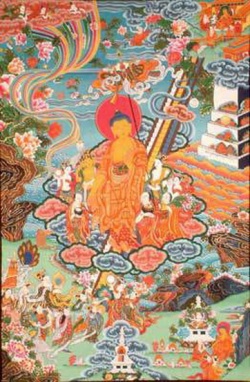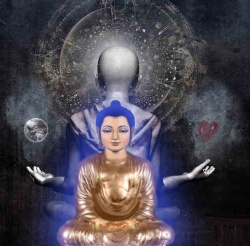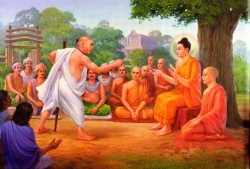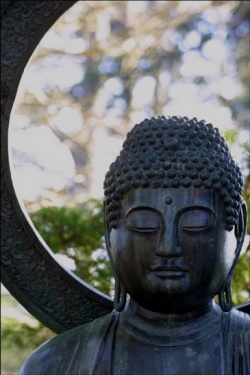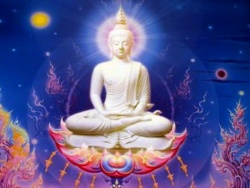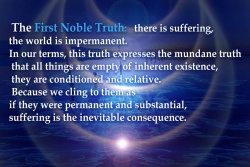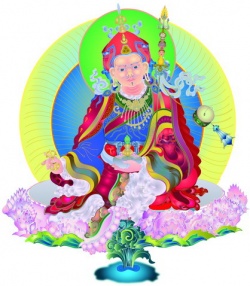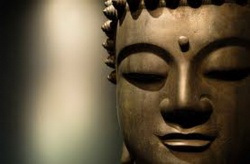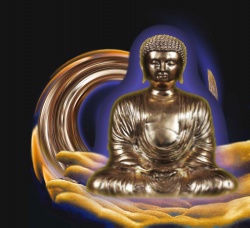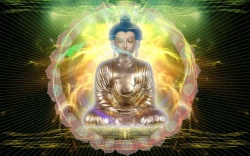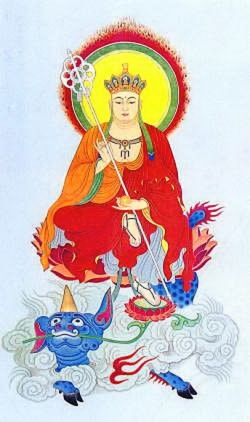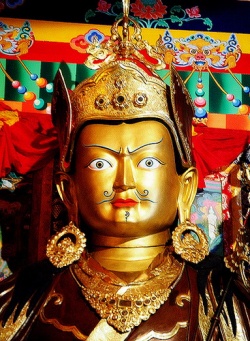Difference between revisions of "Buddhist No-self: An Analysis and Critique"
m (Text replacement - "]]]" to "]])") |
m (Text replacement - "[[[" to "([[") |
||
| Line 168: | Line 168: | ||
That of which one does not have a [[cognition]] when it has been broken is real in a concealing way (samvṛti-sat); an example is a pot. | That of which one does not have a [[cognition]] when it has been broken is real in a concealing way (samvṛti-sat); an example is a pot. | ||
| − | And that of which one does not have a [[cognition]] when other | + | And that of which one does not have a [[cognition]] when other ([[elemental]] qualities ([[dharma]])] have been excluded from it by the [[mind]] is also {{Wiki|conventionally}} real. |
That which is otherwise is [[ultimately real]] ( paramārtha-sat).5 | That which is otherwise is [[ultimately real]] ( paramārtha-sat).5 | ||
Latest revision as of 03:09, 4 April 2016
Buddhist No-self: An Analysis and Critique
The reconciliation of naturalism with the existence of a first-person perspective is the first work of a concept of self. The views of ourselves as corporeal beings and as subjective presences ‘of self to self’ seem to pull in different directions.
Immanuel Kant recognised the tension and sought to resolve it this way:
I may further assume that the substance which in relation to our outer sense possesses extension is in itself the possessor of thoughts, and that these thoughts can by means of its own inner sense be consciously represented. In this way, what in one relation is entitled corporeal would in another relation be at the same time a thinking being, whose thoughts we cannot intuit, though we can indeed intuit their signs in the appearance.
Accordingly, the very same being which, as outer appearance, is extended, is (in itself) internally a subject, and is not composite, but is simple and thinks. (Critique, A359–60)
We stand in two relations to ourselves, one of which is as to a corporeal being and the other as to a subject of experience.
P.F. Strawson says that we should think of ourselves as specimens of ‘a type of entity such that both predicates ascribing states of consciousness and predicates ascribing corporeal characteristics, a physical situation etc. are equally applicable to an individual entity of that type’ (1963: 100), and he identifies the concept of such an entity as the concept of a person.
Strawson is famously dismissive of what he called ‘the “no-ownership” or “nosubject” doctrine of the self’ (1963: 95), according to which it is denied that states of consciousness are ascribed to any subject, a doctrine which implies that our concept of a person is ‘wrong or confused’ (1963: 94).
Strawson, however, notices that in its rejection of the concept of a corporeal person as the owner of states of consciousness, the no-ownership doctrine takes a fundamentally Cartesian view about the nature of ownership, and indeed, that it can be described as a form of dualism, a ‘dualism of one subject – the body – and one non-subject’ (1963: 98),
and he suggests that ‘both the Cartesian and the no-ownership theorists are profoundly wrong in holding, as each must, that there are two uses of “I”, in one of which it denotes something which it does not denote in the other’ (1963: 98).
I wish to return to the no-ownership view, in the formulation it was given by the Buddhist philosopher Vasubandhu.
The centrality of Vasubandhu’s theory to later Hindu critique of Buddhist ‘no-self’ theory lends importance to a clarification of his theoretical position.
My goal here is to retrieve a conception of self in play
64 Hindu and Buddhist Ideas in Dialogue
within Vasubandhu’s Buddhist theory, and to identify the exact grounds on which it is rejected.
My argument will be that the Buddhist rejection presupposes what is in fact a most insightful conception of self.
For Vasubandhu’s aim is not merely to reject some given theory of self in the Indian debate, but to diagnose what he takes to be a deep mistake in our primitive conceptual scheme, and for that it is incumbent upon him to provide an accurate descriptive metaphysics of self.
I will separate the conception described from the error-theory, and argue that bracketing the error-theory leaves a viable conception of self, one which is uncluttered by extraneous theoretical commitment.
I also believe, but will not have time to argue the point here, that the conception of self implicit in Vasubandhu influenced later Hindu theory about self.
The use of the term ‘person’ ( pudgala) is puzzling in Buddhism.
We can distinguish two basic Buddhist positions: a reductionist position and an emergentist one.
A provisional working definition of emergence is this:1
A property P of a mereologically complex object O is emergent if
1. [supervenience] P supervenes on the properties of the parts of O;
2. [non-structurality] P is not had by any of O’s parts and is not a structural property of O, and
3. [autonomy] P has a direct determinative influence on the pattern of behaviour of O’s parts.
The purpose of the third clause is to give sense to the idea that emergence produces properties that are causally autonomous, but it is open whether some other formulation of the autonomy requirement is better.
The so-called Buddhist ‘Personalists’ (Pudgalavādins or Vātsīputrīyas) are emergentists about persons: they claim that the person is an inexplicable product of diachronic aggregation of states of conscious experience. Like the Indian materialists, they point to examples from the natural world to illustrate their theory of mind.
For them, the choice example is the relation between fire and the fuel in which it burns: the fire is dependent on the fuel, but not in the same way that the shape of a heap of sand is dependent on the grains.
Their view is that, like fire, persons are dependent upon but yet irreducible to the constituent ingredients.
They use the term ‘person’ to refer the macrostate of a dynamical system, subject to a microdynamic ( pratītya-samutpāda, ‘combined origination in dependence’) by which its total collective state at one time determines its state at the next. The view is that the micro-elements are in a process of mutation, and that the emergent macrostates yielded by this process of mutation are to be identified as corresponding with mind, just as a flame is something emergent from a 1 Bedau (1997: 376), adapted from O’Connor (1994).
Buddhist No-self: An Analysis and Critique
process of in which the constituent material is continuously in flux. Such a theorist thinks that there is something other than the stream: emergent upon the underlying dynamical system, there are macrostates which take the stream as their owner.
This is what this group of Buddhists give the name ‘person’. Their theory is best understood as the thesis that a person is an ownership relation emergent from the dynamical system that is the interlaced stream of the five sorts of mental particular, or the stream itself in its new capacity to function as a place of ownership. Vasubandhu strongly disagrees.
The exact nature of his disagreement, however, needs to be stated with care. His view is that nothing corresponds to the Pudgalavāda use of the term ‘person’.
That is because he has a no-ownership view, and such views deny that there are emergent macrostates of the sort posited.
Equally clearly, however, he does not deny that streams, the underlying dynamical systems themselves, exist, and it might seem that there is nothing to prevent one using the term ‘person’ to denote that.
He has been called a ‘Buddhist Reductionist’, seeming to imply that he reduces persons to streams. But again, he clearly does not hold a normal reductionist view (the view of Parfit 1984 and 1999, for example).
This is again because he has a no-ownership view, and so, in particular, denies that streams are owners of states of consciousness.
To make progress here, we need to have a still clearer understanding of the ideas of reduction and emergence.
Broad (1925: 581) defined emergent qualities as ‘qualities which are possessed by groups having such and such a structure and such and such constituents but are not deducible from a knowledge of the structure of the group and the qualities of its constituents’.
In another place, he said that ‘an emergent quality is roughly a quality which belongs to a complex as a whole and not to its parts’ (1925: 23).
The adverb ‘roughly’ here is important, because another category of quality shares with emergent qualities that same feature, so-called structural properties.
Something’s shape, for instance, need be the shape of none of its parts, but we would not count it as an emergent property.
This is because it is entirely explicable (‘deducible’) how something’s shape depends on and is a result of the arrangement and shape of its parts. There are thus three ways for a property to be a property of a complex (or whole or aggregate) without necessarily being a property of any of its constituents or parts:2 1.
Scalar sums – For example, the mass of an object is not the mass of any of its proper parts. The mass of the whole is a scalar sum of the masses of the parts.
2. Structural resultants – For example, the shape of an object is not the shape of any of its proper parts. The shape of an object is a structural property, deducible from knowledge of the parts and their arrangement.
3. Emergents – For example, arguably, the biological or psychological properties of an organism emerge from the nature and arrangement of its parts, but are not deducible from knowledge of their nature and arrangement. 2 Armstrong (1978: vol. 2, 69); O’Connor (1994).
66 Hindu and Buddhist Ideas in Dialogue
Jaegwon Kim has argued that the right way to understand the non-deducibility condition characteristic of emergent properties is as a condition that rules out functional reduction (Kim 2006).
What marks out scalar sums and structural properties is that they are functionally reducible to the constituents. The mass of a heap of sand is a function of the masses of the grains; indeed, the function is simply addition.
The conical shape of the heap of sand is also a function of the shapes and positions of the grains; in this case, the function is a more complex one.
What distinguishes emergents, then, if there are any, is that they are not functionally reducible to their constituents. Kim is a reductive physicalist who takes the reduction of the mental to the physical to consist in the functionalisation of mental properties and the identification of their physical realisers.
There is a different and older concept of reduction, still in play and also relevant to our understanding of the Buddhist theory about persons.
This is the model developed by Ernest Nagel, which sees reduction as consisting in the nomic derivation of the laws of the theory to be reduced from the laws of the reducing theory.
Such derivations need auxiliary empirical premises called ‘bridge laws’, which correlate the predicates in the reduced theory with those of the reducing theory:
Bridge Law Requirement. If theory T is to be reduced to T*, for each primitive predicate M of T there must be a bridge law of the form M <-> N, providing M with a coextensive predicate N of T*.3
When the theory to be reduced is a theory of mind, the bridge law might, for example correlate the predicate ‘… is a pain’ with a predicate from the theory of neuroscience, such as ‘… is a C-fibre firing’.
It might then seem that under a Nagel reduction, any statement in the reduced theory can be translated into an equivalent statement in the reducing theory.
One might think, for example, that if the theory of macroscopic middle-sized objects permits of a Nagel reduction to a theory of atoms and their interactions, then our talk about tables and chairs will be translatable into talk about their constituent atomic swarms.
And then one might be led to the conclusion that tables and chairs really are nothing over and above swarms of atoms, or even that swarms are all there really are, and that middlesized objects exist only in name and not in reality.
It is in this context that David Lewis draws a distinction between the cautious and the incautious reductionist: the cautious reductionist does not confuse the ‘nothing but’ clause in a reductionist thesis with a denial of existence.4
3 Kim (2005: 98).
4 ‘A supervenience thesis is, in a broad sense, reductionist.
But it is a stripped-down form of reductionism, unencumbered by dubious denials of existence, claims of ontological priority, or claims of translatability. One might wish to say that in some sense the beauty of statues is nothing over and above the shape and size and colour that beholders appreciate, but without denying that there is such a thing as beauty, without claiming that beauty exists only in a less-than-fundamental way, and without undertaking to paraphrase ascriptions of
Buddhist No-self: An Analysis and Critique
These distinctions are precisely what we need to make sense of Vasubandhu’s view about persons. Vasubandhu insists that ‘person’ is just a name we use for a resultant combination of mental particulars.
He states that whatever exists but is not fundamental physical stuff is such as to disappear when broken up in actuality or in thought:
That of which one does not have a cognition when it has been broken is real in a concealing way (samvṛti-sat); an example is a pot.
And that of which one does not have a cognition when other (elemental qualities (dharma)] have been excluded from it by the mind is also conventionally real.
That which is otherwise is ultimately real ( paramārtha-sat).5
The examples Vasubandhu gives are a pot and (in the autocommentary) a body of water. A pot, clearly, is something which none of its proper parts are: it disappears if broken into its parts.
A body of water seems, on the face of it, to be a stranger example, since water is a fundamental type of elemental material.
I propose that what is going on is that he is mentioning something which is a scalar sum (a body of water) and something which is a structural resultant (a pot), and that the implication is that this exhausts the ways in which combining elements can create something new.
Vasubandhu’s point is then that the ‘new’ properties of the pot are not at a higher metaphysical level than those of its constituents. Although such objects have properties which their constituents do not have, these are merely resultant properties.
When Vasubandhu turns to a discussion of the concept of a person, which he does only in an appendix to the main work,6 he says that the case is exactly the same as with the pot and the water in his earlier example, and he further adds that a person is also like a heap or a river.
Vasubandhu’s thought seems to be this.
If the term ‘person’ refers to anything, it must refer to something which has a property that none of its constituents have.
The lesson from the earlier discussion is that any such property is either a scalar sum or a structural resultant.
There is simply no room for the Pudgalavāda theory, namely that being a person is an emergent property.
To put it another way, Vasubandhu’s argument is that if it is a conceptual truth about persons that they are emergent, then there are no persons.
What Vasubandhu is claiming is there are no persons as persons are conceived of by the Pudgalavādin. His alternative idea is that the only legitimate use of the term ‘person’ is to refer to a structural property of the stream.
Those entities are reducible their constituent experiential tropes, just as a heap or a flow is reducible to its constituents.
beauty in terms of shape etc. A supervenience thesis seems to capture what the cautious reductionist wishes to say’; Lewis (1998: 29). 5 ‘yatra bhinnena tadbuddhir anyāpohe dhiyā ca tat | ghaṭārthavat saṃvṛtisat paramārthasad anyathā ||’ AK 6.4 ||;
Vasubandhu (1975: 334). 6 Vasubandhu (1973: 1,189–234); tr. Duerlinger (2003), Kapstein (2001: 347–74). 7 ‘prajñaptisat pudgalo rāśidhārādivat’; Vasubandhu (1973: 1,205).
68 Hindu and Buddhist Ideas in Dialogue
A different reading of Vasubandhu has it that what he argues is that all talk of persons is mere talk. According to the alternative view, being a person is not a property at all, let alone a resultant one.
It is a fiction, a mere convention. On this reading, he is an incautious reductionist, someone who says that the reduced entities do not really exist at all.
I am arguing that a less uncompromising reading of Vasubandhu is available.
The point at issue is whether one attributes to him an elimination thesis, according to which the existence of a reduction entails that the terms of the reduced theory are not genuinely referential,
or an identity thesis, which says that what best explains the existence of the reduction is that reduced entities are identical to their reducing counterparts, so that persons are identical to diachronic clusterings of mental particulars.
The availability of cautious reductionism, a middle way between eliminativism and emergentism about persons, is most clearly noticed by Vasubandhu’s contemporary, Saṃghabhadra.
The best thing to say about Vasubandhu himself is probably that he did not fully distinguish between these two alternatives to Personalism.
When he denies that there are persons what he is denying is that there is anything corresponding to the Pudgalavāda conception of an emergent entity, not eo ipso asserting that persons are mere fictions.
To say that a person is nothing other than a stream of mental particulars is not of itself to say that a person is nothing at all.
Vasubandhu is an eliminativist about the illegitimate use of ‘person’ and a Nagel reductionist about its legitimate use, with a degree of caution that is unclear.
Saṃghabhadra is more clearly a cautious Nagel reductionist about the legitimate use.
What is clear is that the Buddhist ‘pudgala’ is not a Strawsonian person, something to which both corporeal and psychological predicates are ascribed. The Strawsonian concept is rather that of the Cārvāka puruṣa:
‘A human being ( puruṣa) is a body qualified by consciousness.’8 The Buddhist concept of a pudgala is the concept of an owner of experience, itself emergent from the stream of conscious experience.
Person to Self: Naturalism
Can Buddhist pudgala be seen as a naturalist philosophy of self?
Quine describes methodological naturalism as a consequence of the ‘abandonment of the goal of first philosophy’, which has come about because of ‘the recognition that it is within science itself, and not in some prior philosophy, that reality is to be identified and described’ (Quine 1981: 72).
The suggestion goes back to Hume.
In the introduction to the Treatise, Hume proposes that the old methods of ‘metaphysical reasonings’ be replaced with a new ‘experimental philosophy’.
This new philosophy applies the methods of the sciences to a study of human nature: 8 Cārvāka-sūtra 1.6: ‘caitanya-viśiṣṭaḥ kāyaḥ puruṣaḥ |’; Bhattacharya (2002: 603–4).
For to me it seems evident, that the essence of the mind being equally unknown to us with that of external bodies, it must be equally impossible to form any notion of its powers and qualities otherwise than from careful and exact experiments, and the observation of those particular effects, which result from its different circumstances and situations. (Hume 1978: xvii)
Hume’s failed attempt, using this method, to detect a self is one of the most famous and influential experiments in the history of philosophy:
For my part, when I enter most intimately into what I call myself, I always stumble on some particular perception or other, of heat or cold, light or shade, love or hatred, pain or pleasure.
I never can catch myself at any time without a perception, and never can observe anything but the perception. (Hume 1978: 252)
Hume concludes from this experiment that a self must be something ‘whose different and co-existent parts are bound together by a close relation’, and not something which is ‘perfectly simple and indivisible’.
In the notorious Appendix, he summarises the view that he has advanced in the body of the Treatise thus: When I turn my reflection on myself, I never can perceive this self without some one or more perceptions; nor can I ever perceive anything but the perceptions. It is the composition of these, therefore, which forms the self.
(Hume 1978: 634) With regard to all objects, not just the self, he draws a contrast between ‘the doctrine of philosophers’, by which he means a natural philosophical or scientific attitude, and ‘the doctrine of the vulgar’, the ordinary opinion of common sense:
When I view this table and that chimney, nothing is present to me but particular perceptions, which are of a like nature with all the other perceptions.
This is the doctrine of philosophers.
But this table, which is present to me, and the chimney, may and do exist separately.
This is the doctrine of the vulgar. (Hume 1978: 634)
Hume seems to think, therefore, that his experiment establishes that there is no self understood in the ‘vulgar’ sense as something simple and indivisible.
The same method also establishes that there is no table in the vulgar sense. In the case of the table, of course, the co-existent parts are perceptions of the constituent material parts from which the table is made, the sorts of thing one would see if one were to look at the table through a very powerful microscope.
Introspection, for Hume, is a kind of microscope for the mind, and the mental particulars which it detects – sensible qualities, emotions, thoughts – are the mental parts from which a self is made.
It might now seem that it is only in a rather contrived sense that Hume can say that he does not observe a self, in the strange ‘philosophical’ sense in which he would also say that one does not observe a table: one does not observe a table as something ‘simple and indivisible’ separate from its constituent parts and their properties.
Hindu and Buddhist Ideas in Dialogue
Yet one does observe a table, and one does so in virtue of the pattern of co-existence of its parts.
In that same sense, we might think that one does observe a self when one introspects mental particulars: one observes a self in virtue of the pattern of co-existence of those mental particulars.
Hume’s anxiety in the Appendix is the result of his belief that he can find nothing in perception corresponding to such a pattern of co-existence, and so can form no idea of a self as anything other than a clump and succession of discrete perceptions.
This anxiety, it seems to me, is an inevitable product of Hume’s scientific naturalism.
The patterns of co-existence that ‘bind together in a close relation’ the individual mental happenings are not describable in merely causal terms. They are patterns that must be articulated in a vocabulary unavailable to the Humean naturalist.
Hume’s experiment is a failure. It is a failure because what he set out to detect is not something that could be detected within the design-specification of the experiment he conducts.
His scientific method, of microscopic inspection and introspection, never could detect a self.
So Shoemaker (1996: 24) rightly says that ‘whether we interpret “perceive” in the broad sense or in the narrow sense, the [Humean] view that we have introspective perception of individual mental happenings but not of a self is indefensible’.
The problem with Hume’s naturalism is that his method is blind to the facts which are constitutive of selfhood. He speaks about individual ‘perceptions’, but not to what it is for a subject to own a perception.
A concept of self affords an explanation of the sources – real or illusory – of the distinction between what is mine and what is another’s.
In so far as it does indeed supply such an explanation, our interim conclusion is that the operative concept of self at work in Buddhist theory is neither Cartesian, nor Strawsonian, nor Humean.
First-person Psychological Ascription and Unconscious Ownership What does Vasubandhu say about the ownership of conscious experience? In his later, post-Abhidharma, writing, he postulates the existence of an aspect of experience which he calls manas.
He says that this manas is a way of being aware, associating it with the activity of ‘thinking’ (manana); that it takes the storeconsciousness (ālayavijñāna) as its foundation; that it undergoes a transformation ( pariṇāma) into something that we metaphorically call a self, but also that this transformation is the work of cognitive fabrication (vikalpa) and there is in fact no such thing:
For the metaphorical designation of self, which functions in several ways, is upon the transformation of consciousness. Based on it [sc. the store-consciousness), there functions the consciousness called manas, which consists in mentation (manana) having that as its base.
Buddhist No-self: An Analysis and Critique
This transformation of consciousness is a cognitive fabrication, and what is cognitively fabricated by it does not exist.
The import of the use of the terms ‘conceptual fabrication’ (vikalpa) and ‘metaphorical designation’ (upacāra) in connection with the self is that the end result of the transformation of pre-attentive self-consciousness is the sort of firstperson present-tense psychological ascription one would express in the words ‘I am F.’
The transformation has made the self into a conceptual thought-content; but the expression of that thought-content uses a word, ‘I’ for example, in some way that is not one of genuine literal reference. The claim is that three distinct phenomena are involved in self-consciousness:
1. conscious attention to one’s own states of mind (manovijñāna) This must have a base (āśraya). The base is:
2. a pre-attentive mode of being self-aware (manas)
This is subject to transformation ( pariṇāma). What it is transformed into is: 3. first-person present-tense ascription of a psychological state (ahaṃ-pratyaya) – thinking ‘I am F’ for some psychological predicate F.
My possession of a first-person view, a view on my own mental life, has to be underwritten.
What underwrites it is the fact that my mental life presents itself to me, in a primitive and pre-attentive way, as being mine.
This same primitive mode of being self-aware is rendered in such a way that it seems to justify me in making assertions of the form ‘I am F.’
In fact, it is never the case that assertions of such a form are true of a self. Uses of ‘I’ never literally refer. The proposal we are examining might be expressed as the conjunction of three propositions:
(1) There is a pre-attentive mode of self-awareness because of which my experiences present themselves to me as mine.
(2) First-person present-tense ascription of a psychological state draws upon additional conceptual resources, ones not available on the basis of (1) alone.
(3) First-person psychological ascriptions do not actually involve genuine reference to a self.
Can one hear an echo of Vasubandhu’s new thought in the following remark (the very remark, as it happens, out of which Strawson constructed the noownership view; 1963: 95, n.1)?
9 ‘ātmadharmopacāro hi vividho yaḥ pravartate | vijñānapariṇāme ’sau ||’ 1a–c ‘|| tasya vyāvṛtir-arhatve tad-āśritya pravartate | tad-ālambaṃ manonāma vijñānaṃ mananātmakam ||’ 5 ‘|| vijñāna-pariṇāmo ’yaṃ vikalpo yad-vikalpyate | tena tan-nāsti ||’ 17a–c ||; Triṃśikāvijñapti- kārikā; tr. Richard Robinson, in Lusthaus (2002: 275–91).
72 Hindu and Buddhist Ideas in Dialogue
One of the most misleading representational techniques in our language is the use of the word ‘I’, particularly when it is used in representing immediate experience, as in ‘I can see a red patch.’
It would be instructive to replace this way of speaking by another in which immediate experience would be represented without using the personal pronoun. (Wittgenstein 1975: 88)
In another place, Wittgenstein speaks of ‘two different cases in the use of the word “I” (or “my”)’, the use ‘as object’ and the use ‘as subject’ (1960: 66–7). The use ‘as object’ is the use to which it is put when we refer to ourselves as human beings, embodied entities in a public space, the use it has when, for example, one person says to another, ‘I am just going to the shops to get the paper’ or ‘I have twisted my ankle.’
Having distinguished between these two uses, one strategy would be to identify one of these uses as the primary use, and analyse the other use as being in some way derivative upon the first.
The derivative use is metonymic or modulated – the term is used to refer to something else, which stands in some relation to the primary referent.
A variant on this approach is recommended by Galen Strawson.
Strawson argues that the two uses are both genuinely referential, and neither is primary – in short, that ‘I’ is not univocal.
One use is to refer to what he describes as a ‘thin subject’, which is ‘an inner thing of some sort that does not and cannot exist at any given time unless it is having experience at that time’ (2008: 156).
The other use is to refer to the human being ‘considered as a whole’:
Are we thin subjects? In one respect, of course, we are thick subjects, human beings considered as a whole.
In this respect we are, in being subjects, things that can yawn and scratch. In another respect, though, we are in being subjects of experience no more whole human beings than hands or hearts: we are – literally – inner things, thin subjects, no more things that can yawn or scratch than eyebrows or thoughts …. –
But ‘What then am I?’ Am I two different sort of things, a thin subject and a thick subject? This is ridiculous …. My answer is that ‘I’ is not univocal.
We move naturally between conceiving of ourselves primarily as a human being and primarily as some sort of inner subject (we do not of course naturally conceive of ourselves as a thin subject).
Sometimes we mean to refer to the one, sometimes to the other; sometimes our semantic intention hovers between both, sometimes it embraces both. (Strawson 2008: 157–8)
Vasubandhu, although he does not say so here, would perhaps be content to endorse as ‘conventional’ (saṃvṛti-sat) the use of the first person in statements like ‘I am going to the shops’, a use governed by the token-reflexive rule that ‘I’ refers to the speaker.
When ‘I’ is used in the expression of first-person present-tense ascription of a psychological state, however, his claim is that the reference to an inner self fails, that this use erroneously imports a subject–predicate model and imposes it upon one’s inner experience.
In other words, his view of this use of ‘I’ is that there is a combination of metonymy and error-theory.
When ‘I’ is used metonymically 9781409443544_Prasad.indb 72 4/11/2012 3:23:21 PM
Buddhist No-self: An Analysis and Critique
to refer to the inner subject, something always goes wrong, and what goes wrong is that there is nothing at the far end of the metonymic relationship for it to refer to.
According to the interpretation of Vasubandhu we have reached, then, ‘I’ does not function as an expression of genuine reference, but is rather one of disingenuous reference: it is a referring expression without a referent, its use creating the false impression that there is one. That is, I suggest, the best way to understand Vasubandhu’s claim that it is a ‘metaphor’.
The claim that the first person itself, the word ‘I’, is used ‘metaphorically’ in reporting the contents of the first-person perspective, therefore clearly rests on a prior commitment to the nonexistence of an inner subject of experience. Only this permits him to claim that its use is one of what I have called ‘disingenuous reference’.
What we have seen, however, is that a no-ownership theorist need not deny that a sense of ownership accompanies experience, a sense which is grounded in the subconscious activity of manas.
One can deny that first-person present-tense ascriptions ascribe states of consciousness to subjects without falling into the incoherence, identified by Strawson, of denying that experience is necessarily experience as that of someone.
What is No-self?
If the ambition of Buddhist philosophy is to recommend that we assume a spectatorial or third-person stance on our own mental lives, then one promising idea is that what is distinctive of a first-person position is that thoughts are associated with a detachable phenomenology of ownership.
In Vasubandhu’s model of the mind, when we make present-tense self-ascriptions, we do so on the basis of a pre-existing sense of ownership that attaches to our thoughts. In normal cases, I experience my thoughts as things I have thought myself, rather than things someone else has thought and put in my mind.
A plausible way to make sense of Vasubandhu’s position is to take it that what he recommends is the detaching of a sense of agency from our thoughts.
Ownership, Vasubandhu states explicitly, is a causal relation, a matter of how it is generated and not what its entitlements are (Abhidharmakōśabhāṣya 1975: 1,217).
This consideration leads to a first formulation of the Buddhist ‘no-self’ claim: No-self [first formulation]:
The phenomenology of ownership that accompanies normal thinking should be eradicated.
‘No-self’ is the advice to turn to forms of mental training whose outcome is that the trainee’s thoughts no longer carry with them any sense that they have been generated by, authored by, the subject themselves.
This does not have to imply that they are felt of as being someone else’s thoughts, but rather that they are occurrences from the phenomenology of which any sense of agency, and so ownership, has been removed.
It is important that the phenomenology is one of thoughts not felt as generated, rather than as one of thoughts felt as generated by _Prasad.indb
Hindu and Buddhist Ideas in Dialogue
someone else; for a sense that the thoughts to which one has first-person access are generated by someone else soon leads to distinctive sorts of mental disintegration, and that is not at all what Vasubandhu sees as the aim of philosophy.
What Vasubandhu is saying is that we are in the grip of a false phenomenology when we have a sense that we ourselves have agency with respect to our thoughts.
We need training to break that phenomenology, and if the training works, it will not be as if all our thoughts are someone else’s, but rather that they are as if arising unbidden, spontaneously.
Vasubandhu distinguishes, as we have seen, between two dimensions of self-awareness: mano-vijñāna, which is third-person knowledge of one’s mind, and manas, which is an additional sense of being-mine, and which transforms merely third-person knowledge into first-person self-knowledge (Triṃśikā 5).
The addition of manas marks the distinction between a merely spectatorial view of one’s inner life and a participant’s view.
Unlike Hume, Vasubandhu is thus fully aware that there is an important distinction between first-person and third-person stances.
He does not take the first-person stance to consist in the operation of anything like an inner sense, and he firmly rejects any Cartesian perceptual model of self-knowledge.
The whole weight of the Buddhist ‘no-self’ can now be seen to rest on a further idea, and one which belongs to practical reason, not to theoretical reason. This is the idea that if we want to lead our lives well, we should not assume a first-person stance, but instead should adopt a spectatorial or deliberative stance.
We should do this because only by doing so can we immunize ourselves against the temptations of egotism and self-pride, and cultivate compassion. Vasubandhu is explicit that manas, the distinguishing feature of a deliberative stance, is also kliṣṭa, ‘afflicted’, the source of all the vices associated with self-centredness (Triṃśikā 6). So a second formulation of the Buddhist ‘no-self’ claim is this:
No-self [second formulation]: The first-person stance that accompanies normal thinking should be suspended.
According to Vasubandhu, it is best to have an entirely third-person, spectatorial stance with respect to one’s mental life. Buddhism is the theoretical defence of a life committed to the cultivation of the disengaged, impersonal, intellect.
Vasubandhu does not make the voluntarist mistake of supposing that one can simply choose to suspend the first-person stance.
The techniques that will bring about such a transformation of mind do not themselves use reason or philosophical argument.
There is a presumption, therefore, that the way of a no-self philosophy is not itself a philosophical way. There is a presumption too that the first-person stance can be suspended, and indeed, that it would be a good thing to do so.
Buddhist No-self: An Analysis and Critique
A Sustainable Attitude?
Vasubandhu’s analysis of the first-person stance is very perceptive. I have argued that it is free from any trace of a Cartesian conception of ownership, and is able to side-step Strawson’s criticism of the no-ownership view.
What I am critical of is the dismissive attitude towards the first-person stance, something which I have argued is constitutive of the Buddhist no-self view.
Vasubandhu recommends that we should give up a first-person stance and cultivate an entirely theoretical stance towards our mental lives. Yet virtues such as autonomy rest on a preservation of the idea of ownership:
The respect that individuals claim for their preferences, commitments, goals, projects, desires, aspirations, and so on is ultimately to be grounded in their being the person’s own.
It is because those preferences, commitments, and so on are a person’s own that disregarding them amounts to disregarding him or her qua that distinctive individual.
By contrast, disregarding preferences, commitments, and so on that are the product of coercion or deception does not seem to involve a violation in the same sense, raising the vexing issue of what makes some preferences, commitments, and so on ‘one’s own’, and others not.
(Christman and Anderson 2005: 9)
So, for example, in order to resist the impositions of a tyrant, one needs a conception of self that can sustain demands for one’s autonomy and individual rights to be respected.
The view of Vasubandhu is a much more resilient version of the no-ownership doctrine than Strawson’s reconstructed position. Vasubandhu presents an extremely perceptive analysis of the first-person perspective and of the phenomenology of ownership.
I have argued that Buddhist ‘no-self’ theory should be understood as an attitude towards, not an analysis of, this phenomenology.
I began by saying that the reconciliation of naturalism and the first-person stance is the first work of a concept of self. Neither Buddhist refusal of the virtues of a first-person perspective nor non-Buddhist anti-naturalism is an acceptable way to fulfil this obligation; both are abrogations of the philosophical task that a theory of self ought to be responsive to.
Strawson sought a middle ground with his theory of persons, but Strawsonian persons are not selves. My view is that the doctrine of manas can be made to serve as a very good account of the self, and that only a prior meta-philosophical commitment prevents Vasubandhu from acknowledging it as such.
Conceived as a self, this manas is neither Cartesian, nor Humean, nor Strawsonian. Moreover, and unlike many accounts of the self, it is properly individuated.
The distinction between manas and pudgala is an anticipation of the contemporary idea that we should distinguish within the concept of self distinct strands corresponding to minimal and narrative conceptions of self.
Vasubandhu is right, I suggest, to see that there is a transformation ( pariṇāma) involved in the transition from a basic pre-attentive sense of ownership to the grounding of present-tense first-person ascription of psychological predicates.
76 Hindu and Buddhist Ideas in Dialogue
this ‘transformation’ consists precisely in the genuine emergence of self within an individual’s mental life. It is indeed true that concomitant with the formation of self there emerges too a capacity for pride, conceit, and all the other self-regarding moral psychological afflictions; but the cure for them is the rational cultivation of a moral identity, not the use of techniques that undermine one’s very possession of a participant stance.





